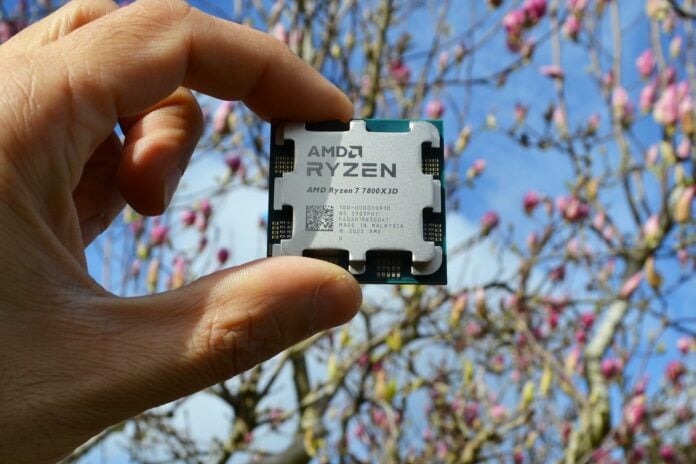AMD Ryzen has been exceeding expectations since 2017 with some of the best CPUs. We’ve enjoyed more cores, higher IPC and faster speeds through generations, but the largest step change in gaming performance arrived when novel 3D V-Cache was first implemented on Ryzen 7 5800X3D. Slapping on an extra 64MB of L3 does wonders for CPU-bound framerate, and it’s the main weapon AMD uses to fend off rival Core when wooing gaming enthusiasts.
Ryzen 7000 Series expands this cache-enhancing portfolio to a further three chips, augmenting the solitary offering for Ryzen 5000 Series. We’ve seen what Ryzen 9 7950X3D can do previously, though foibles emanating from juggling twin CCDs, together with a premium price, put it out the reach of many. What’s needed is a single-CCD chip with a more amenable price tag; a natural successor to change-the-game Ryzen 7 5800X3D.
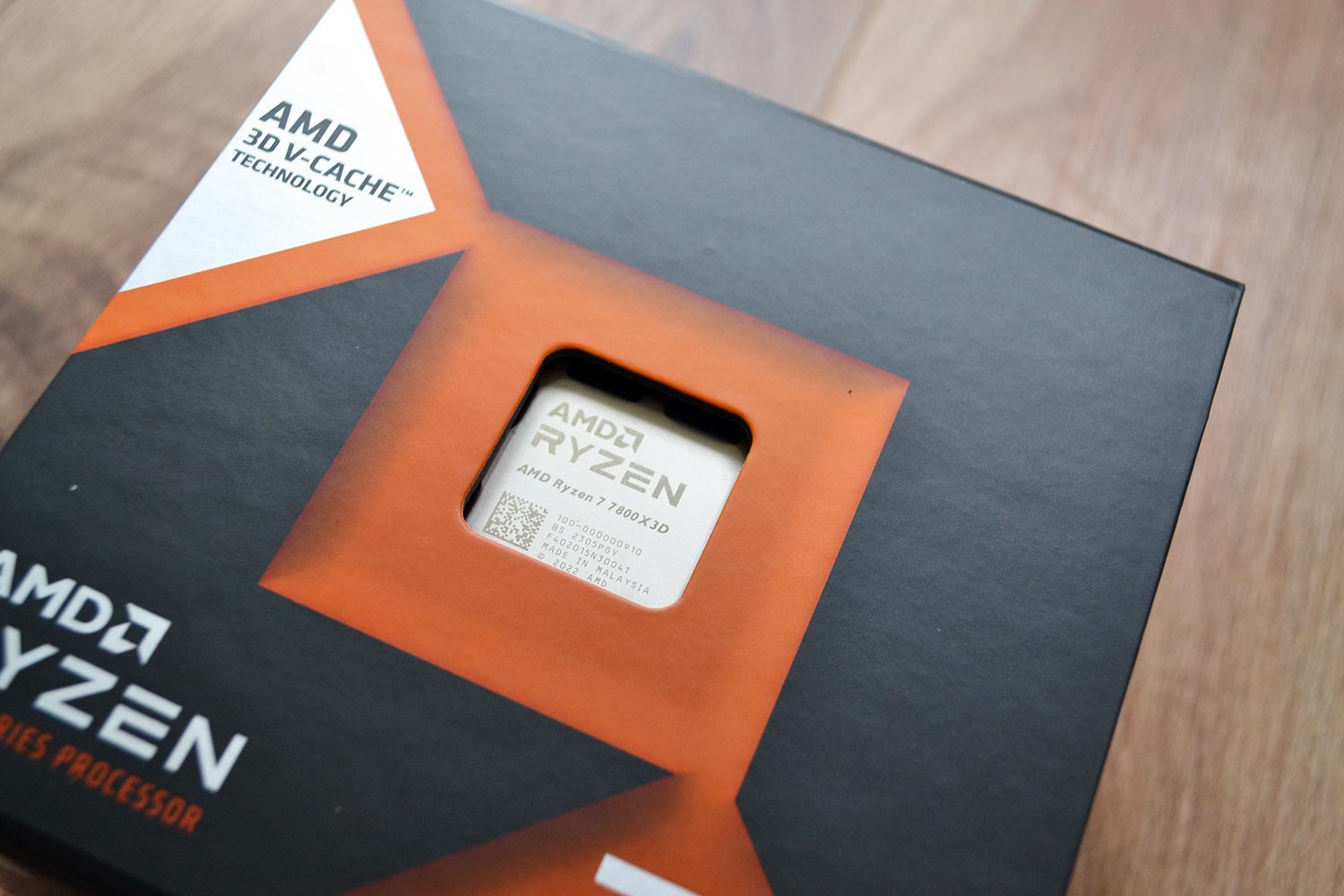

AMD Ryzen 7 7800X3D
£449 / $449
Pros
- Superb at gaming
- Scarily frugal
- Forward-looking platform
Cons
- Low peak frequency
- Mediocre app performance
- Not great value
Club386 may earn an affiliate commission when you purchase products through links on our site.
How we test and review products.
Guess it’s up to today’s review of Ryzen 7 7800X3D to take up the cudgels and defend AMD’s honour in gaming. On-chip cache is king as far as PC gaming is concerned, so bring on the fps!
How Ryzen 7000 Series X3D Models Stack Up
| Model | Cores / Threads | TDP | L3 Cache | Base Clock | Boost Clock | Launch MSRP |
|---|---|---|---|---|---|---|
| Ryzen 9 7950X3D | 16 / 32 | 120W | 128MB | 4.2GHz | 5.7GHz | $699 |
| Ryzen 9 7950X | 16 / 32 | 170W | 64MB | 4.7GHz | 5.7GHz | $699 |
| Ryzen 9 7900X3D | 12 / 24 | 120W | 128MB | 4.4GHz | 5.6GHz | $599 |
| Ryzen 9 7900X | 12 / 24 | 170W | 64MB | 4.7GHz | 5.6GHz | $549 |
| Ryzen 7 7800X3D | 8 / 16 | 120W | 96MB | 4.2GHz | 5.0GHz | $449 |
| Ryzen 7 7700X | 8 / 16 | 105W | 32MB | 4.5GHz | 5.4GHz | $399 |
| Ryzen 5 7600X | 6 / 12 | 105W | 32MB | 4.7GHz | 5.3GHz | $299 |
Coming in as the cheapest X3D part from this generation, a few important matters are evident from the off. The first is restrained frequency. Take a peek at Ryzen 7 7700X, directly underneath, and there’s pause for concern, as that lower-designated CPU runs significantly faster on both base and boost clocks. In fact, 7800X3D’s peak 5.0GHz speed is considered slow for a leading-edge processor. An exercise in undue conservatism.
AMD can certainly make a faster X3D chip, of course, as 7950X3D hums a long at 5.7GHz, wrapped inside the same 120/162W TDP/PPT power envelope. We’re unsure as to why AMD is so coy with frequency, and we foresee clear instances where 7700X is faster than dearer 7800X3D in regular multi-core applications.
Deflecting attention away from speeds and feeds by pointing out this is a gaming chip doesn’t make a great deal of sense, either, as we’ve historically proven sky-high MHz help framerate – just take a look at rival Intel Core i9-13900KS for confirmation. Curious.
Nevertheless, 7800X3D’s ace in the gaming hole is that extra 64MB of L3 cache over and above regular models featuring the same single-CCD design. Understanding precisely how AMD implements this technology is an in-depth discussion in itself, so do immerse yourself in appreciating the expertise in play.
Limited Overclocking
As before, Ryzen 7000 X3D Series chips are multiplier-locked at the factory. That’s a real shame as a large part of AMD’s regular desktop appeal is unfettered access to all facets of performance. Nevertheless, it’s not all bad news, as there’s limited scope to push the chip past out-the-box frequencies.
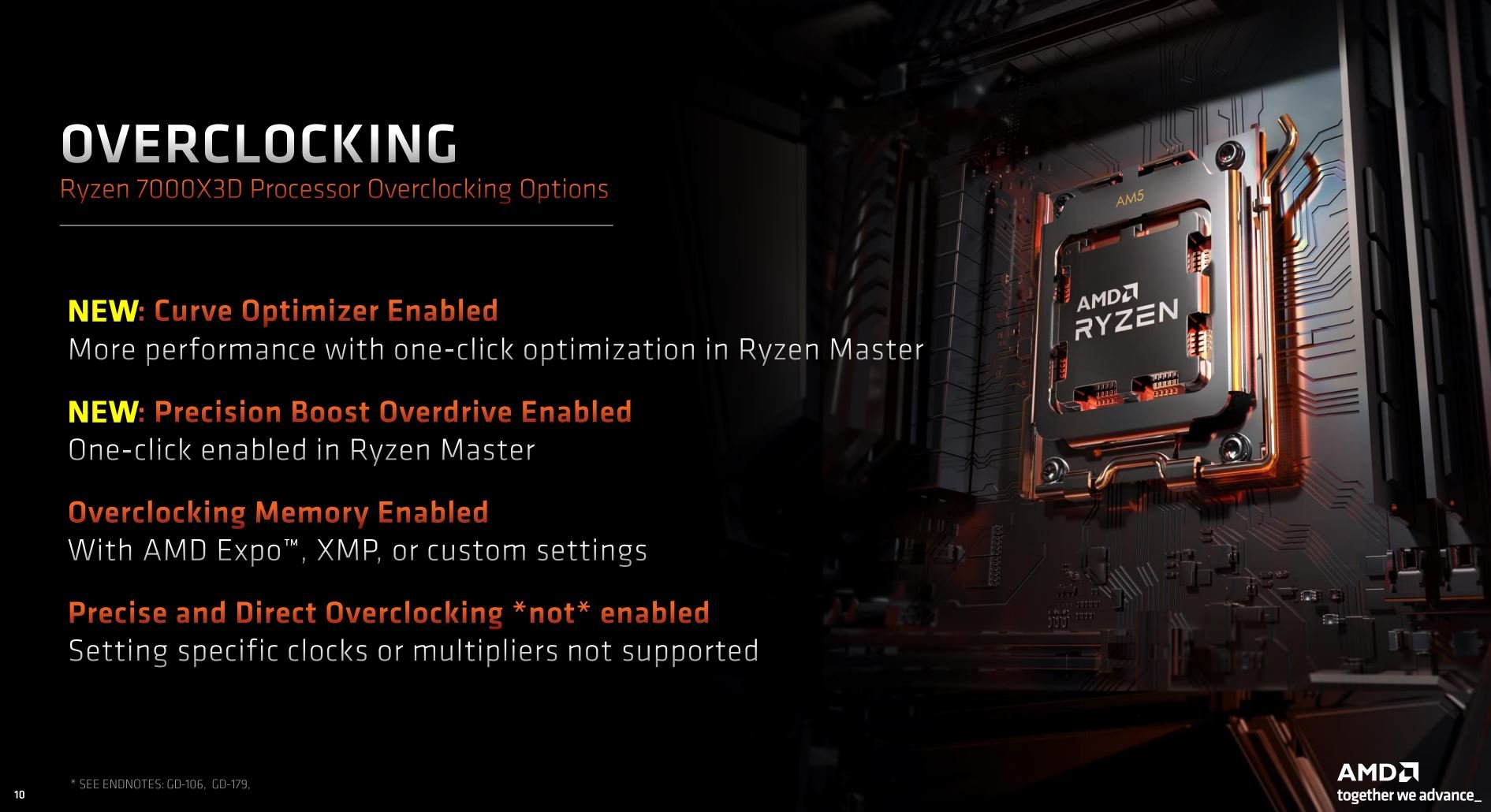
First port of call for any enthusiast is the Ryzen Master software. AMD allows X3D chips to benefit from the ‘Curve Optimiser’ feature, where a little extra headroom is granted by examining the potential of the actual CPU silicon, rather than generic speeds mandated by AMD. Furthermore, whilst being locked in the 120W/142W TDP/PPT mode, Precision Boost Overdrive can also be used to eke out a tad more performance. But it’s only a little, going by AMD’s slides, as the obvious inhibiting factor is locked wattage and voltage.
A Word on Installation
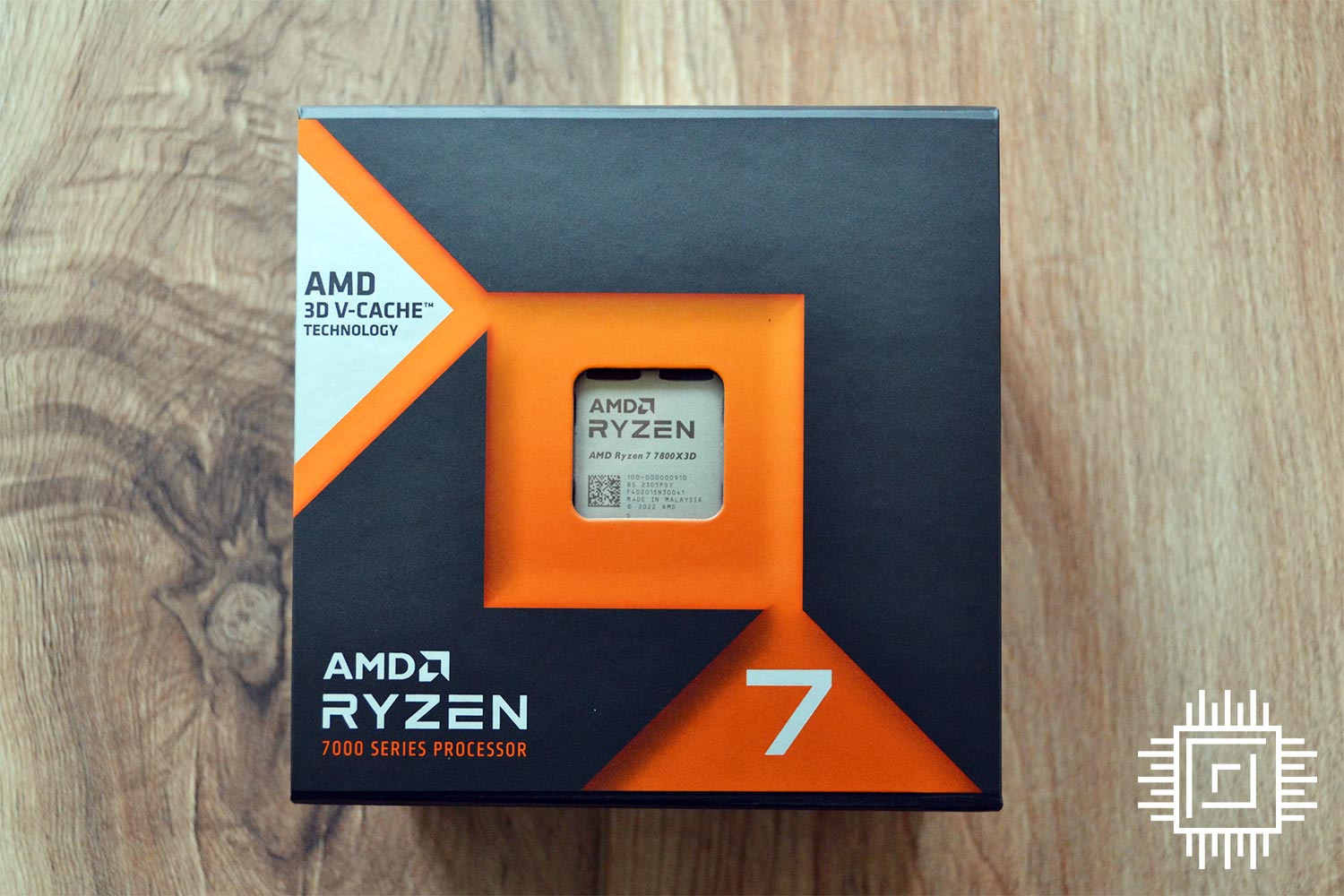
Having a 120W/162W TDP/PPT means Ryzen 7 7800X3D fits into a wider range of motherboards, and even nascent A620 series offerings have enough electrical prowess to manage the load easily. Restrained power usually indicates there’s a cooler in the box, but AMD limits such opportunities to 65W models and below.
Interestingly, AMD recommends a clean install of Windows should you have a Ryzen 9 7950X3D or 7900X3D in situ previously. Granted, such advice is only relevant to a small group of people – including expert testers such as Club386 – and the rationale is that AMD’s PPM provisioning file driver, used to force dual-CCX chips into single-access mode, doesn’t play well with Ryzen 7 7800X3D.
Kind of worrying if you think about it; all processors ought to be plug and play. We tested on both the existing and a fresh install and noted performance discrepancy of up to five per cent, particularly when gaming. The main issue, it transpires, is a phenomenon known as core parking, where PPM reduces the speed of up to three of 7800X3D’s cores without justification. A nuisance most consumers would be unlikely to run into, but let’s be clear, one shouldn’t have to install a fresh OS, for optimum performance, when flitting between dual- and single-CCD X3D chips.
Performance
Ryzen 7 7800X3D deserves to be tested on a top-notch motherboard. Enter the ASRock X670E Taichi updated to the latest 1.18.1006 BIOS and sporting the necessary cache-appreciating driver. Further outfitted with 32GB (2x16GB) of G.Skill Trident Z5 Neo EXPO memory operating at AMD’s official specification, 5,200MT/s, plus Nvidia GeForce RTX 3080 graphics and Noctua NH-D15 cooling. All posted numbers are from a fresh install of Windows 11.
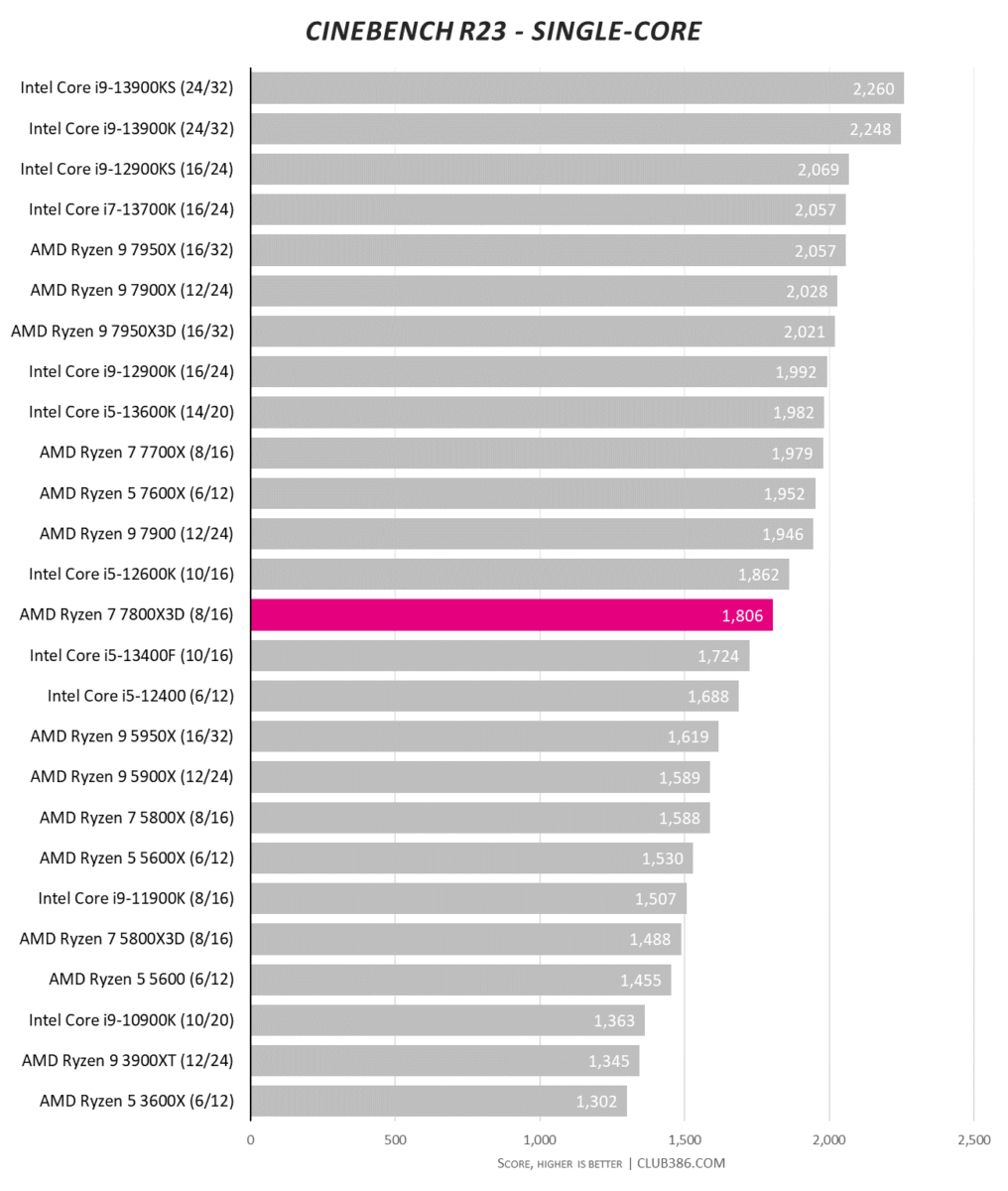
The first indication of productivity performance arrives in the single-threaded test. It’s all down to frequency, and it’s no surprise Ryzen 7 7800X3D is the slowest of the Zen 4 bunch. This is the price to pay for limiting peak speed to 5.0GHz.
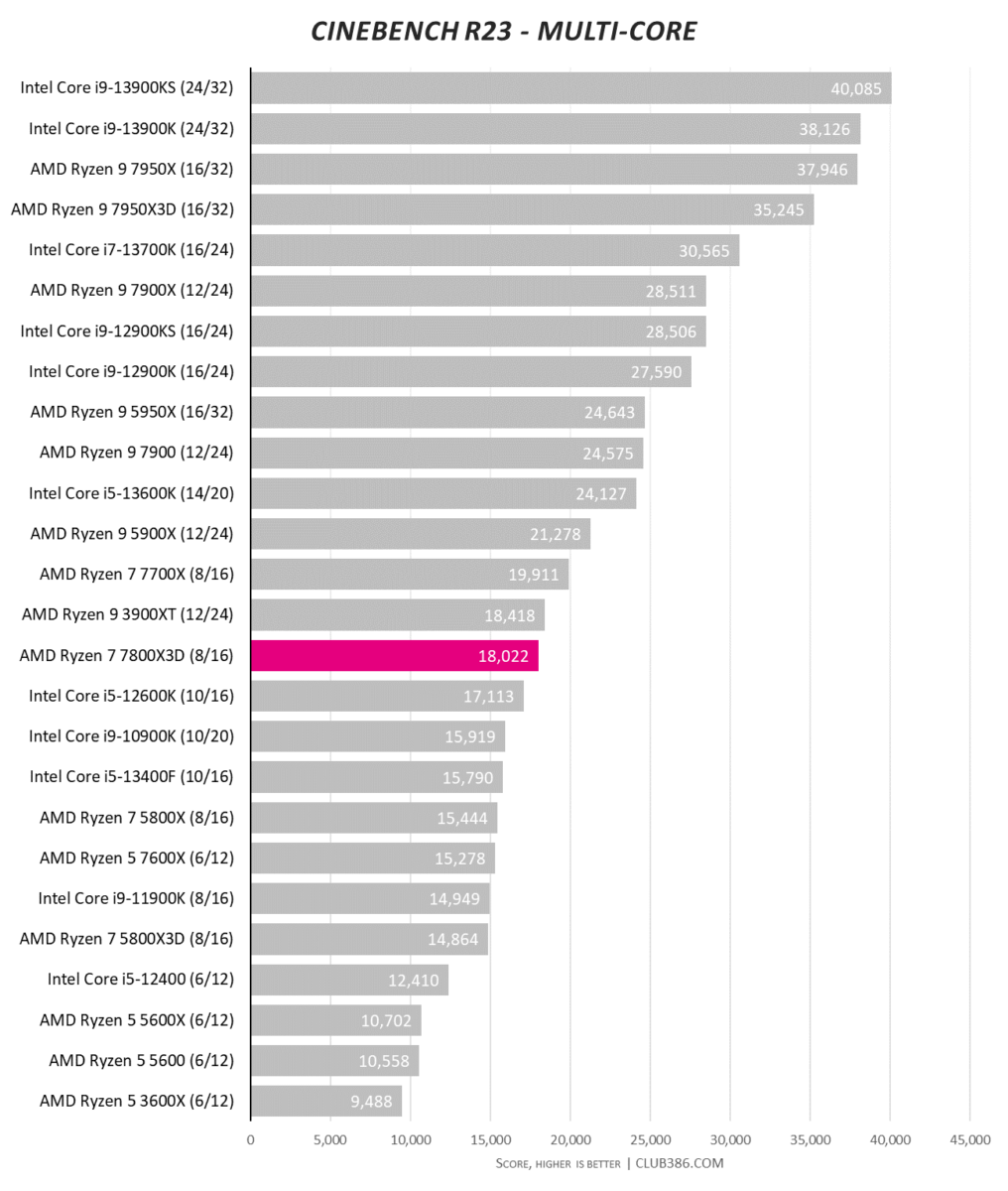
Ryzen 7 7800X3D remains about 10 per cent slower than 7700X, for the same reason, in multi-threaded tests. It’s also far, far behind price-comparable Intel Core i7-13700K, too, so if you’re looking for an all-round chip, this X3D is not it.
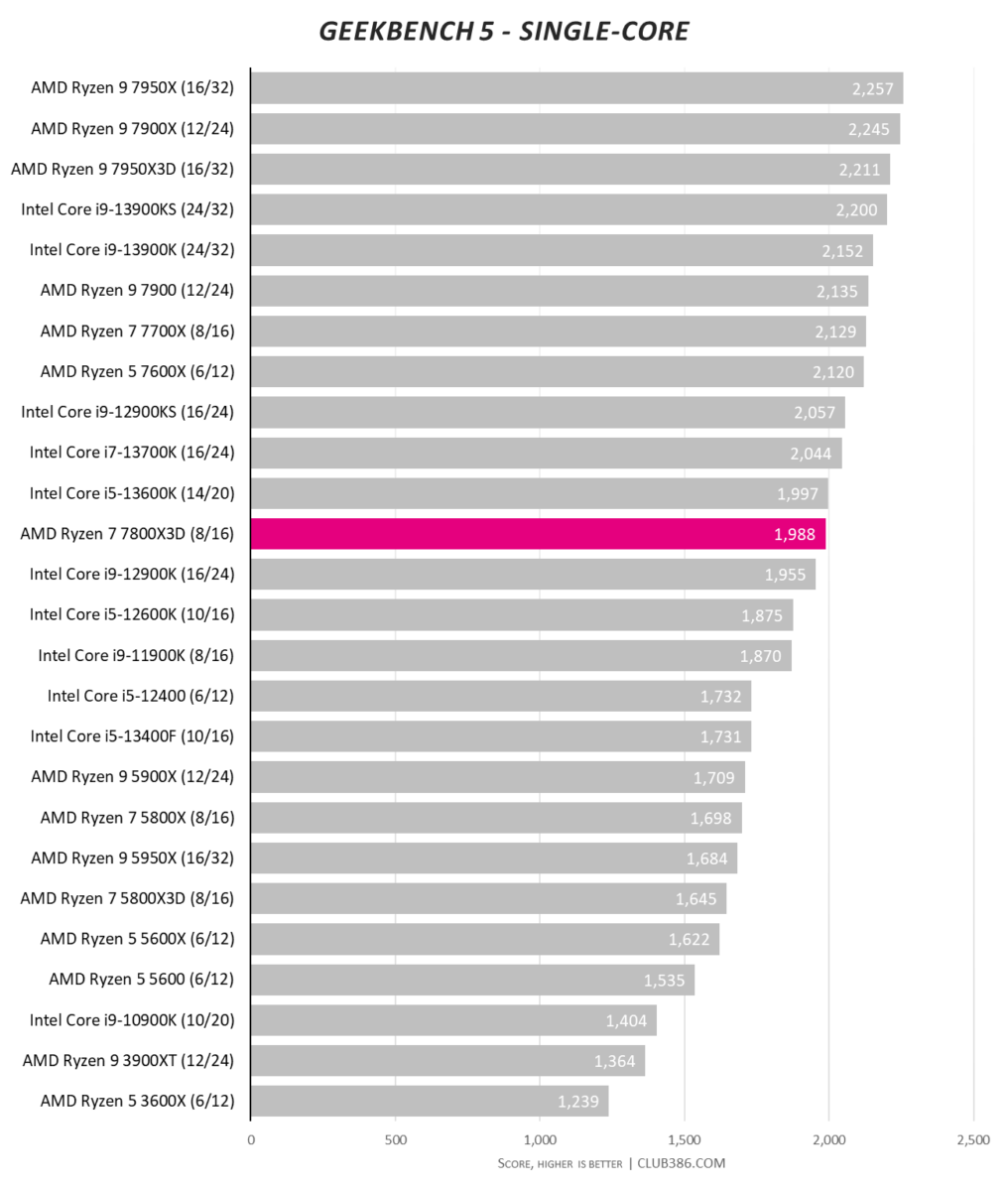
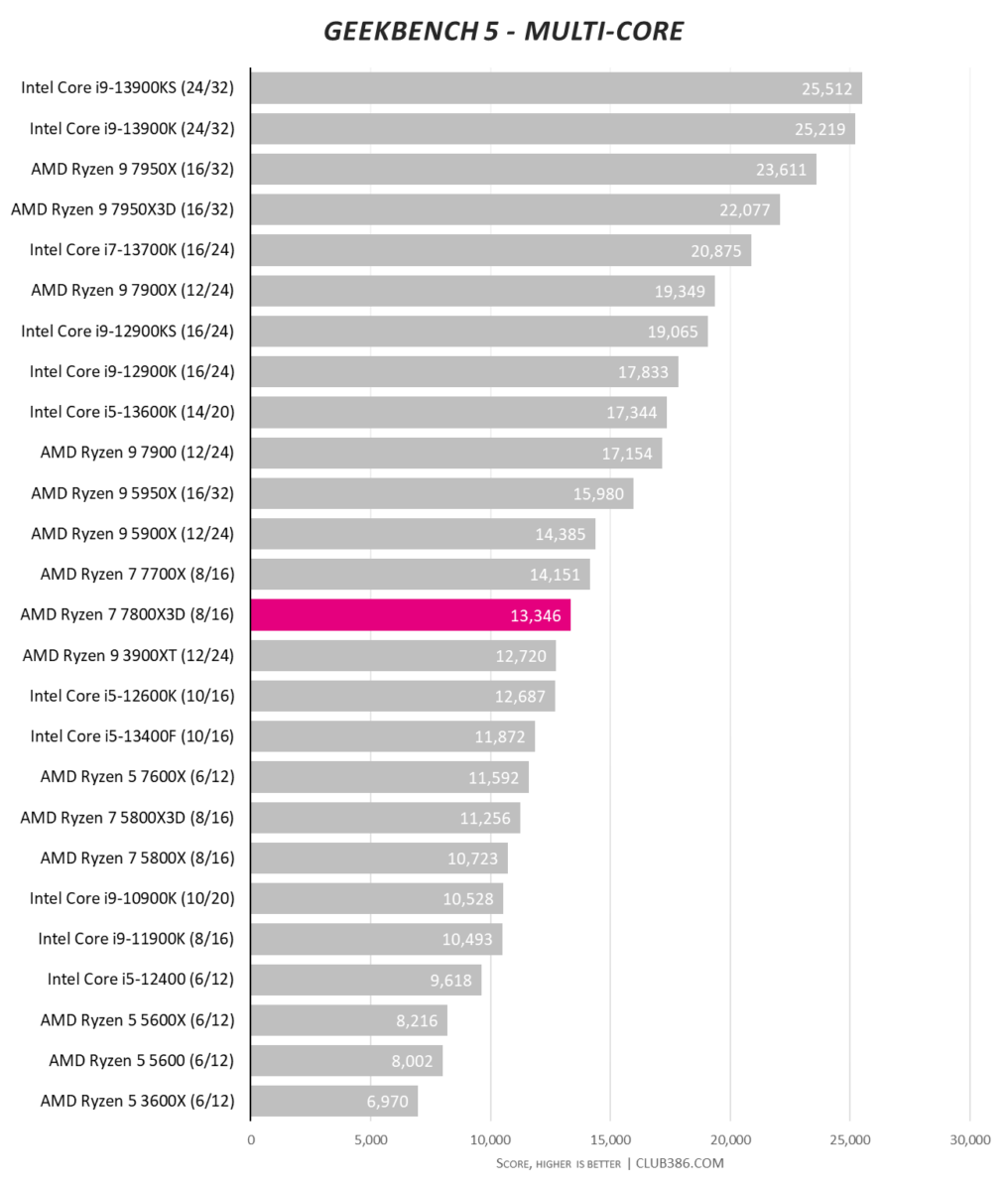
Mid-pack performance belies the $449 asking fee.
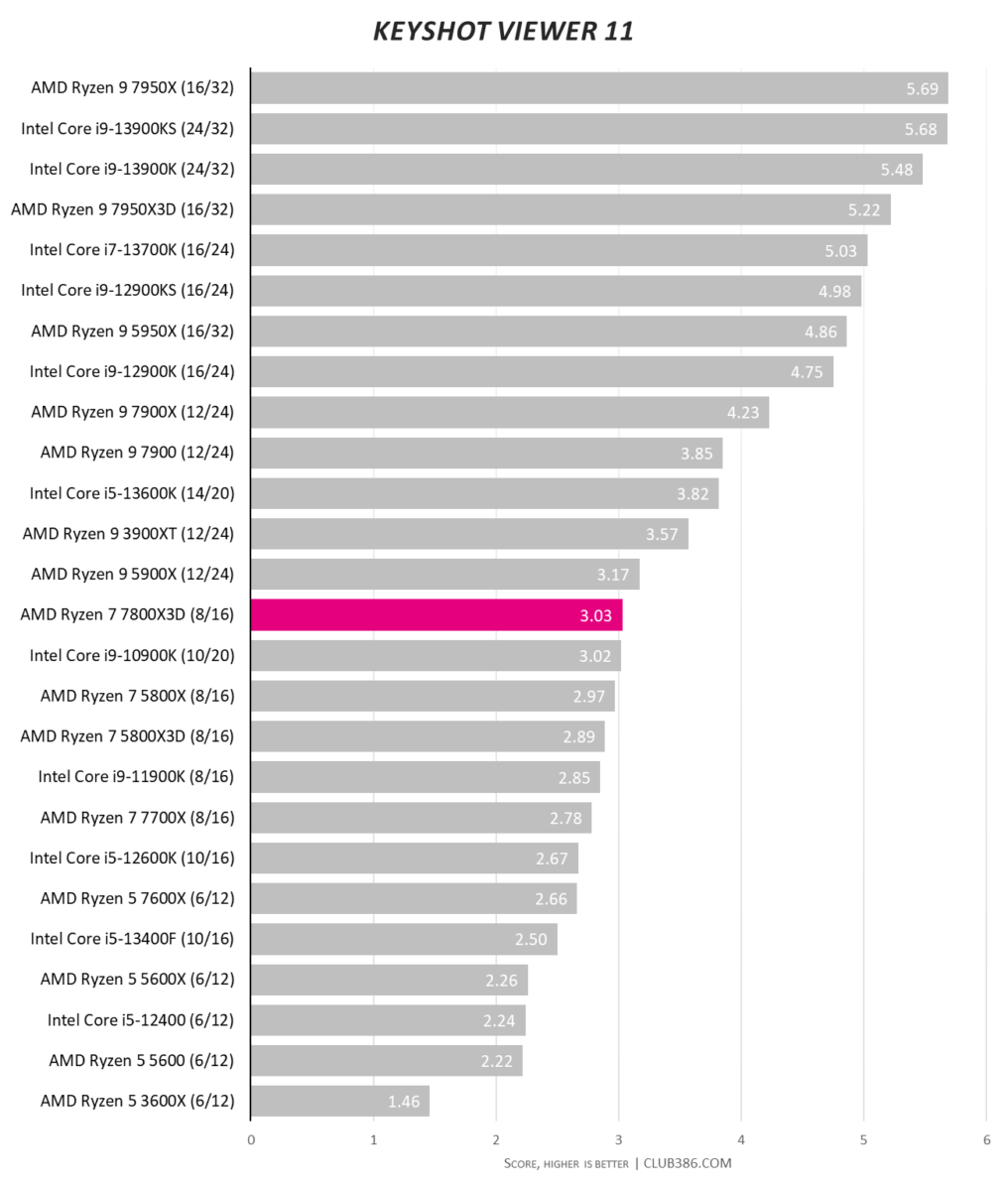
| Core i7-13700K | AMD Ryzen 7 7700X | AMD Ryzen 7 7800X3D | |
|---|---|---|---|
| 7-zip 19.00 (higher is better) | 157,712 MIPS | 119,843 MIPS | 114,660 MIPS |
| Blender 3.3.0 (higher is better) | 454.8 samples | 311.4 samples | 287.57 samples |
| V-Ray 5.0.20 (higher is better) | 21,430 samples | 15,100 samples | 14,204 samples |
| y-cruncher 9513 (lower is better) | 148.1 seconds | 167.8 seconds | 178.0 seconds |
We’ve taken the liberty of benchmarking four additional multi-threaded applications, comparing to Core i7-13700K and Ryzen 7 7700X. Results speak for themselves; Ryzen 7 7800X3D loses every benchmark.
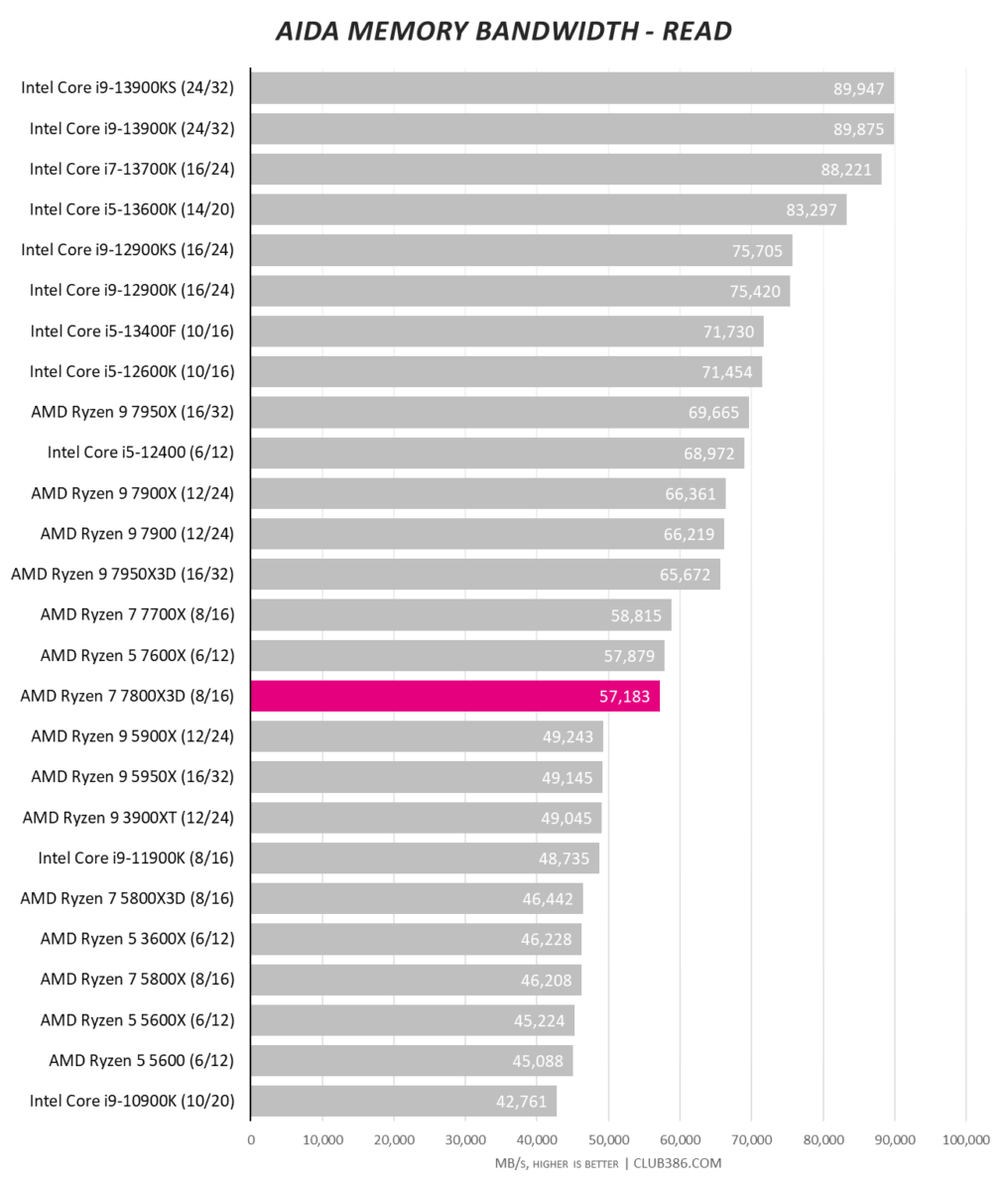
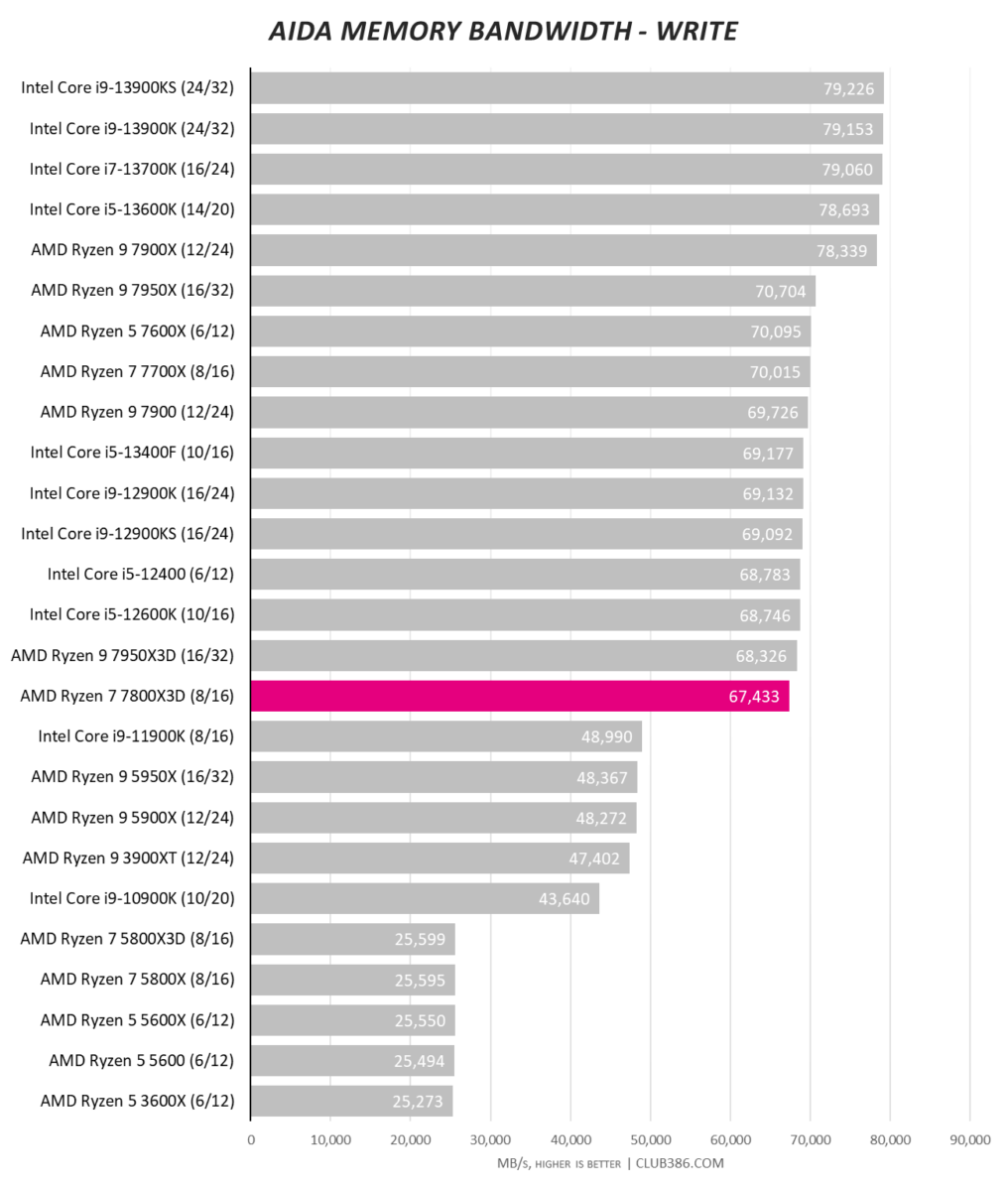
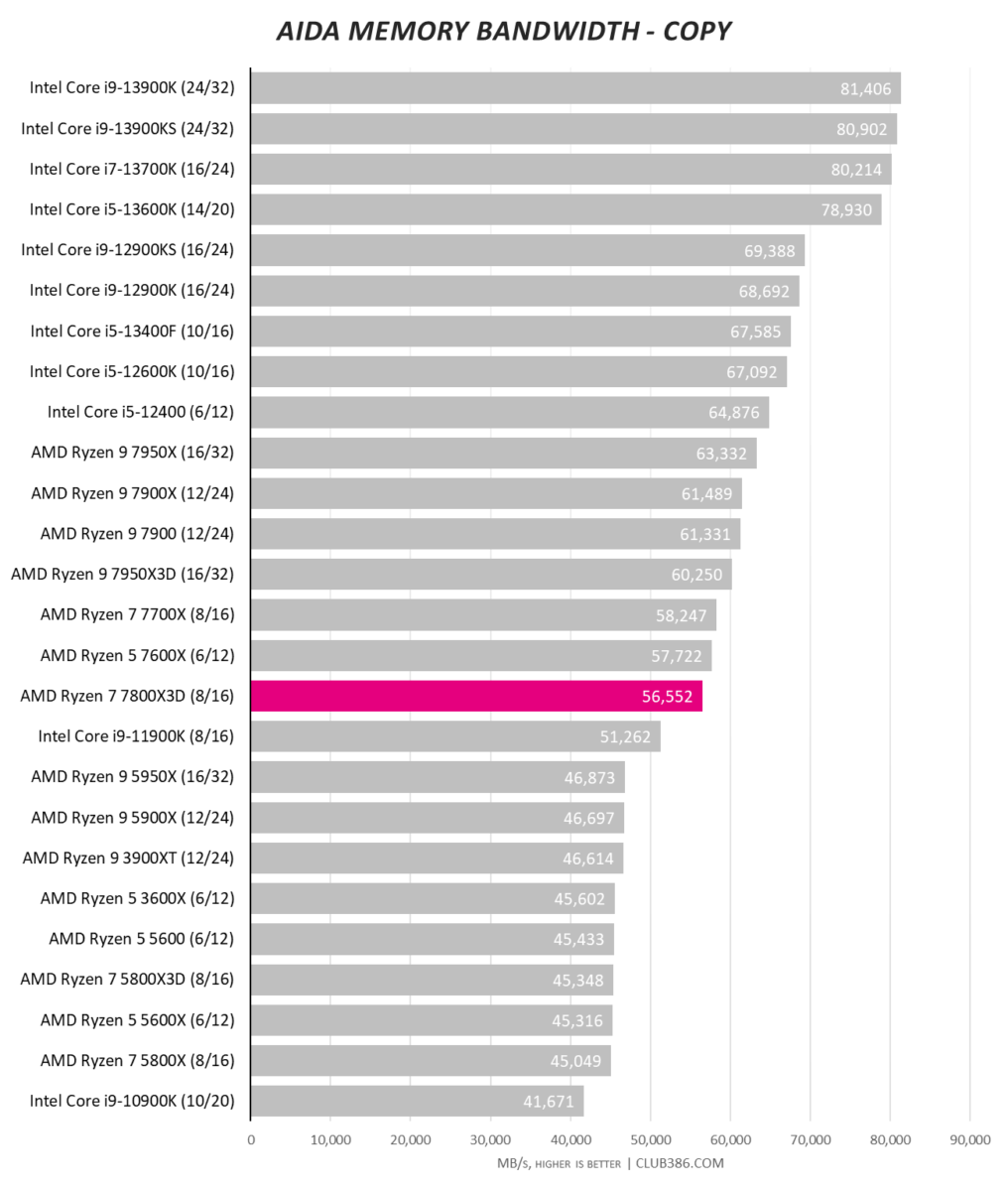
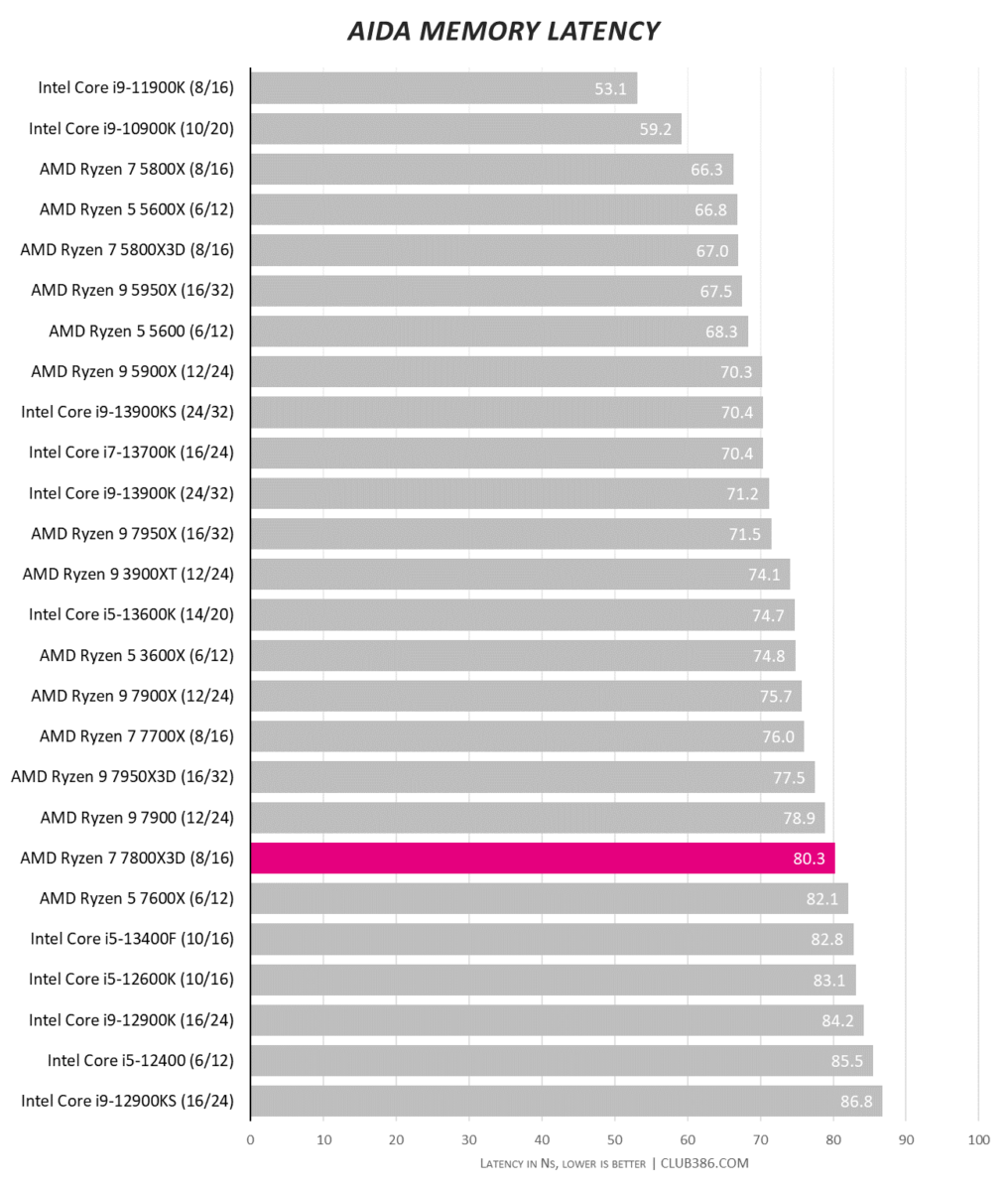
Memory speed and latency is just where we’d expect it to be for a chip run with officially-supported DDR5-5200 memory operating at CL30.
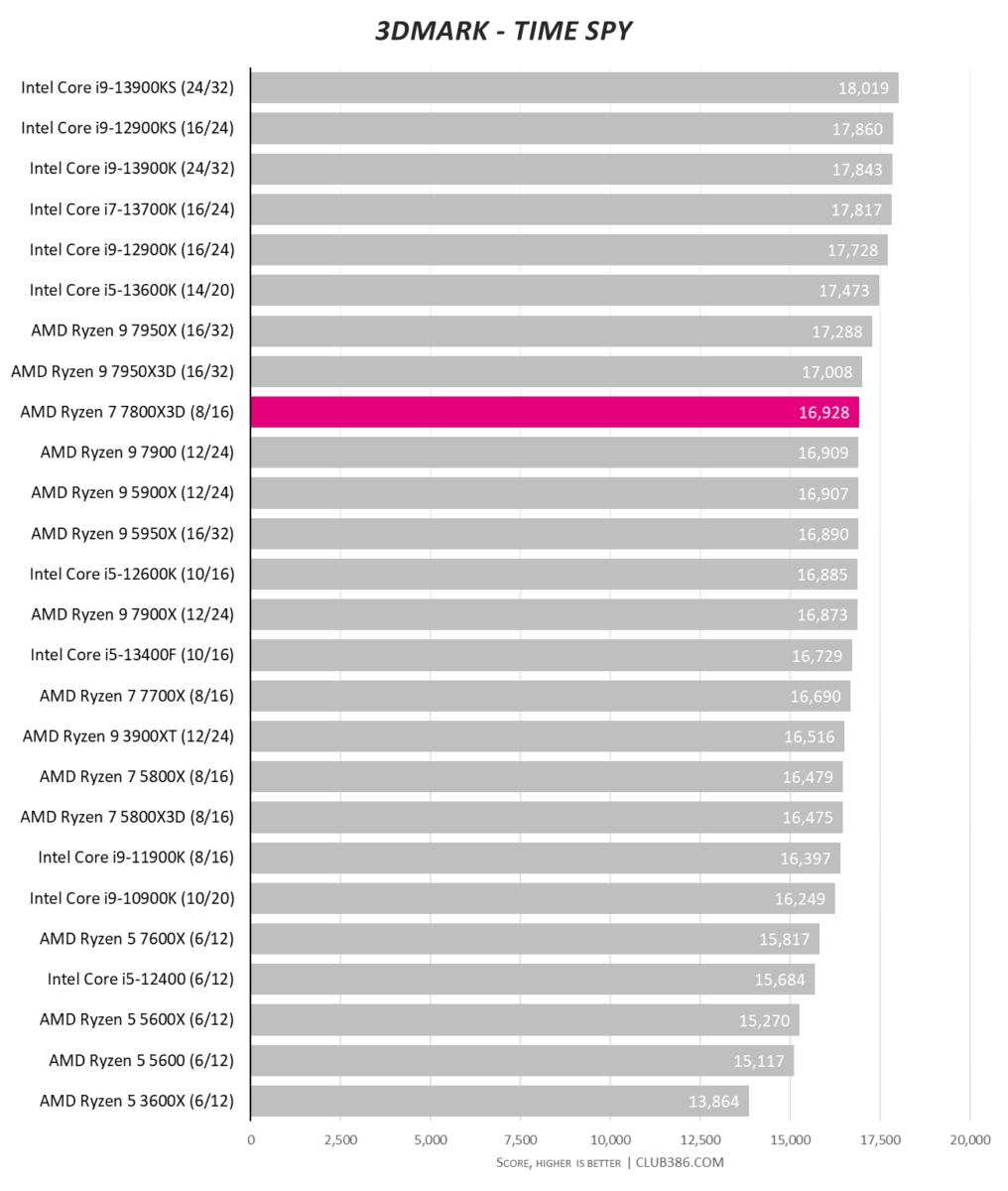
This is better, as the CPU is helping move performance along in 3DMark.
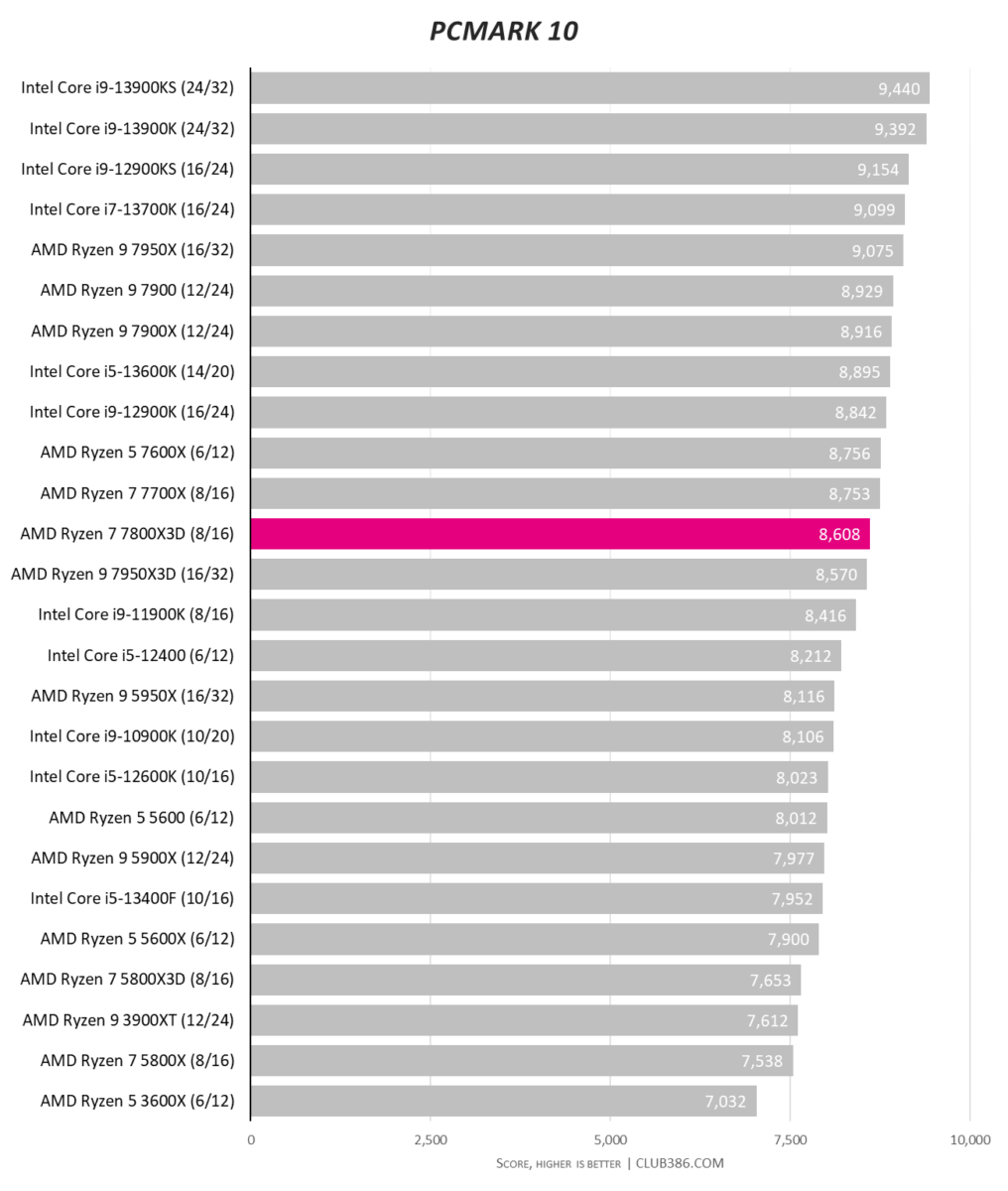
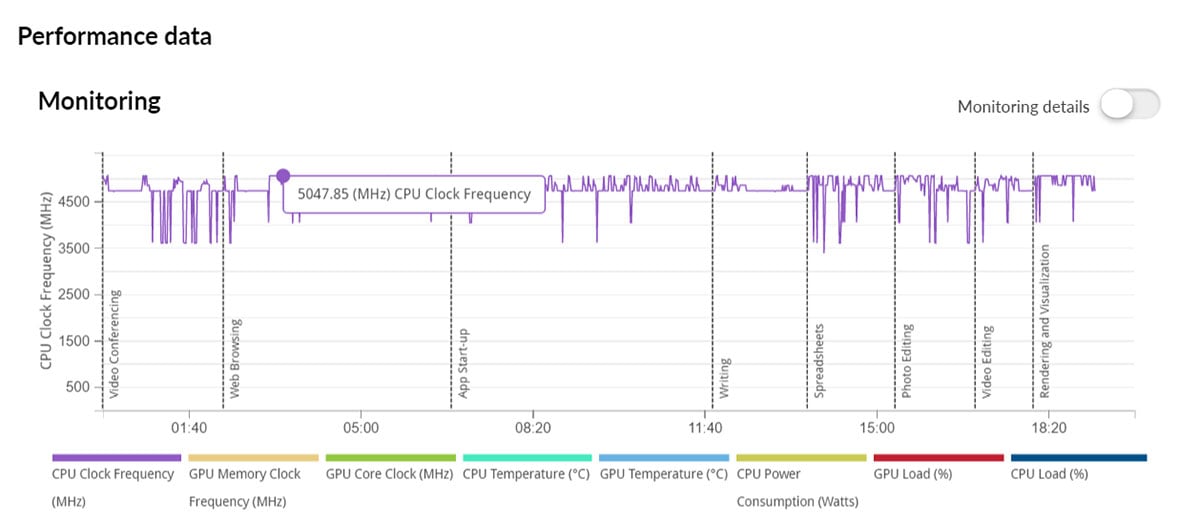
You’ll notice here the chip does boost to 5GHz – and a bit beyond, actually – more often than not.
Gaming
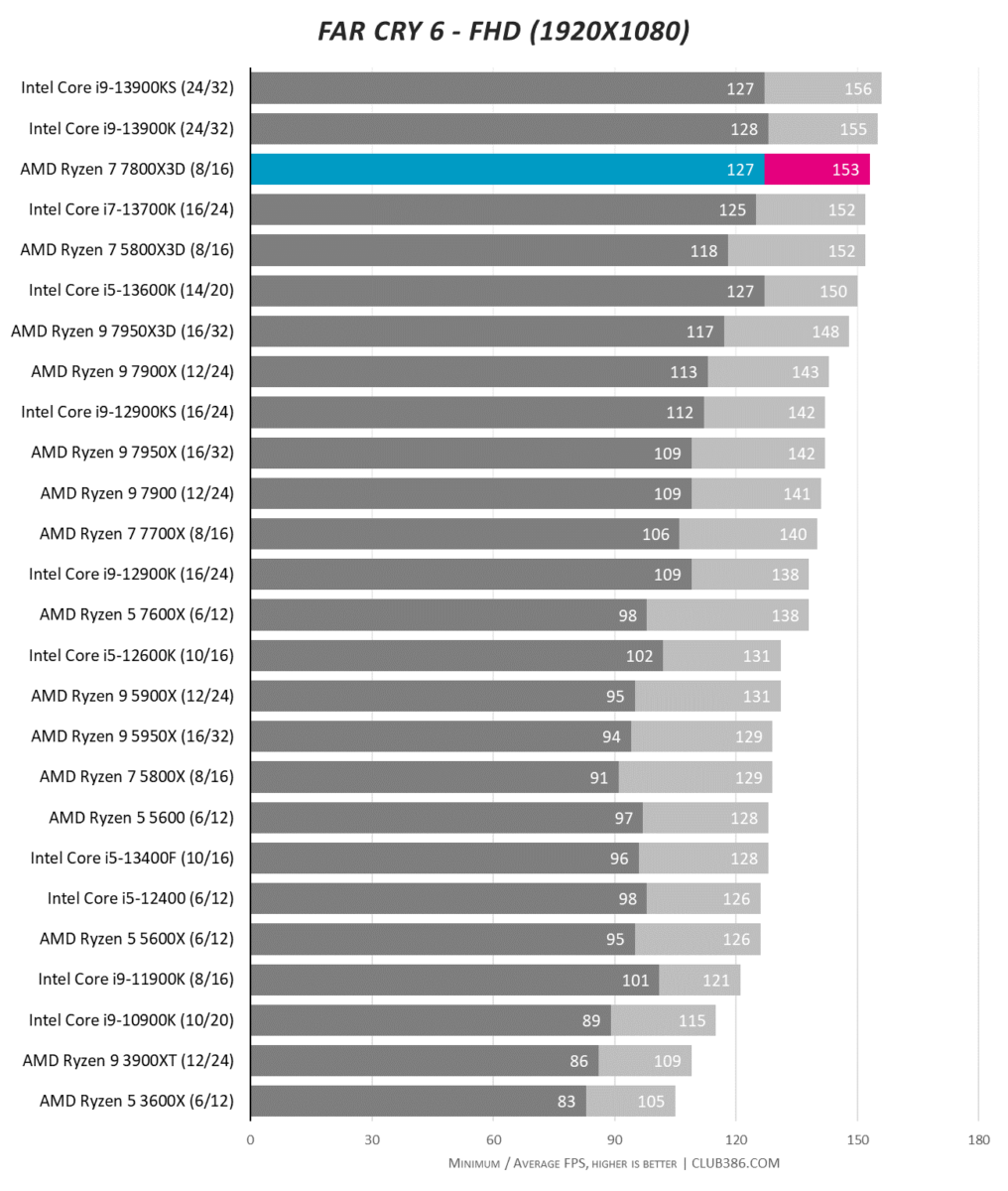
For many, regular application performance is not the main reason to consider an X3D chip. No, sir, gaming is where it’s at.
Coming in hot, our first benchmark paints Ryzen 7 7800X3D in a positive light, just as AMD intended.
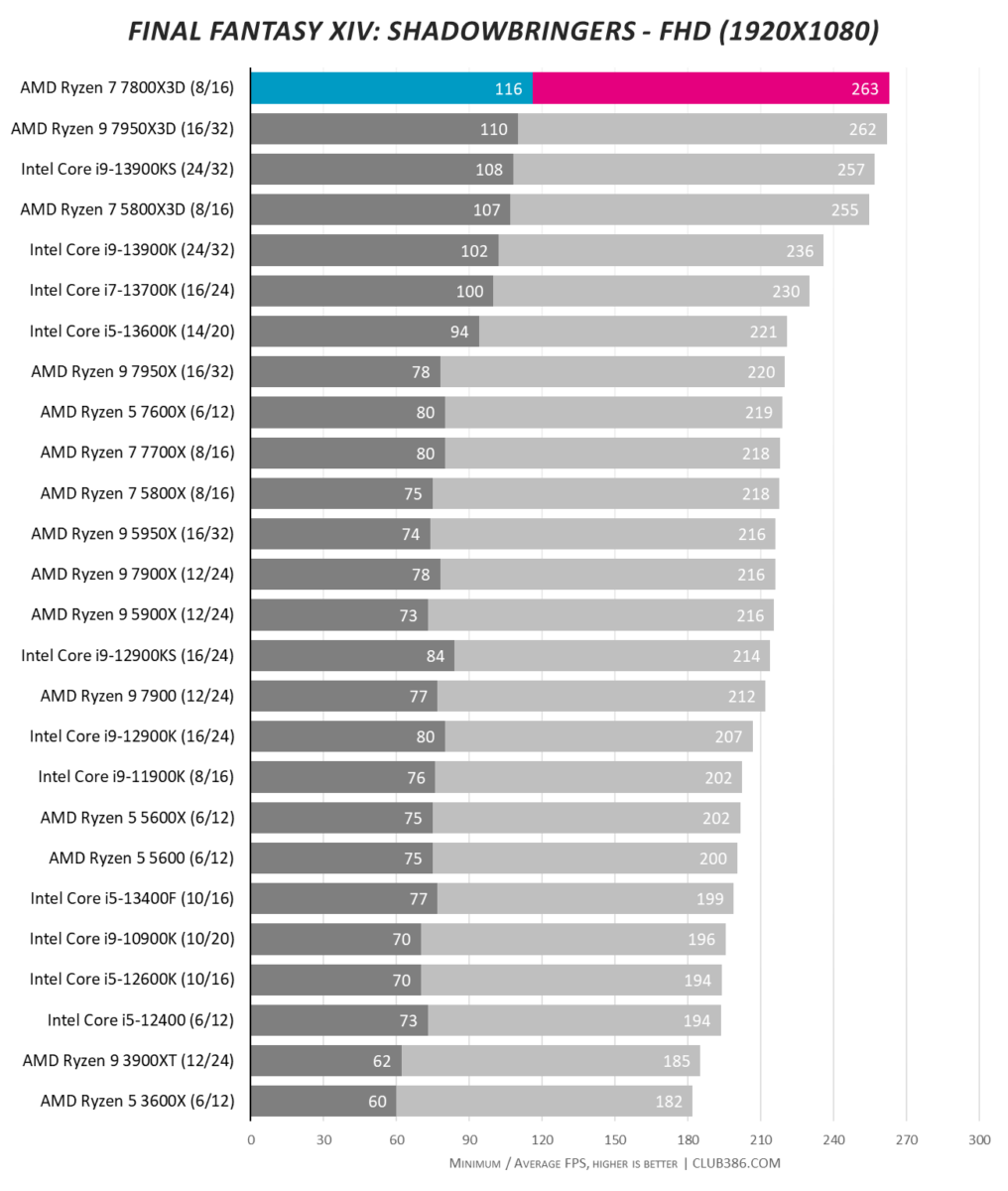
Moving swiftly to the top of the charts, imagine what a 5.8GHz-clocked Ryzen 7 7800X3D+ could do? AMD, can we have one, pretty please?
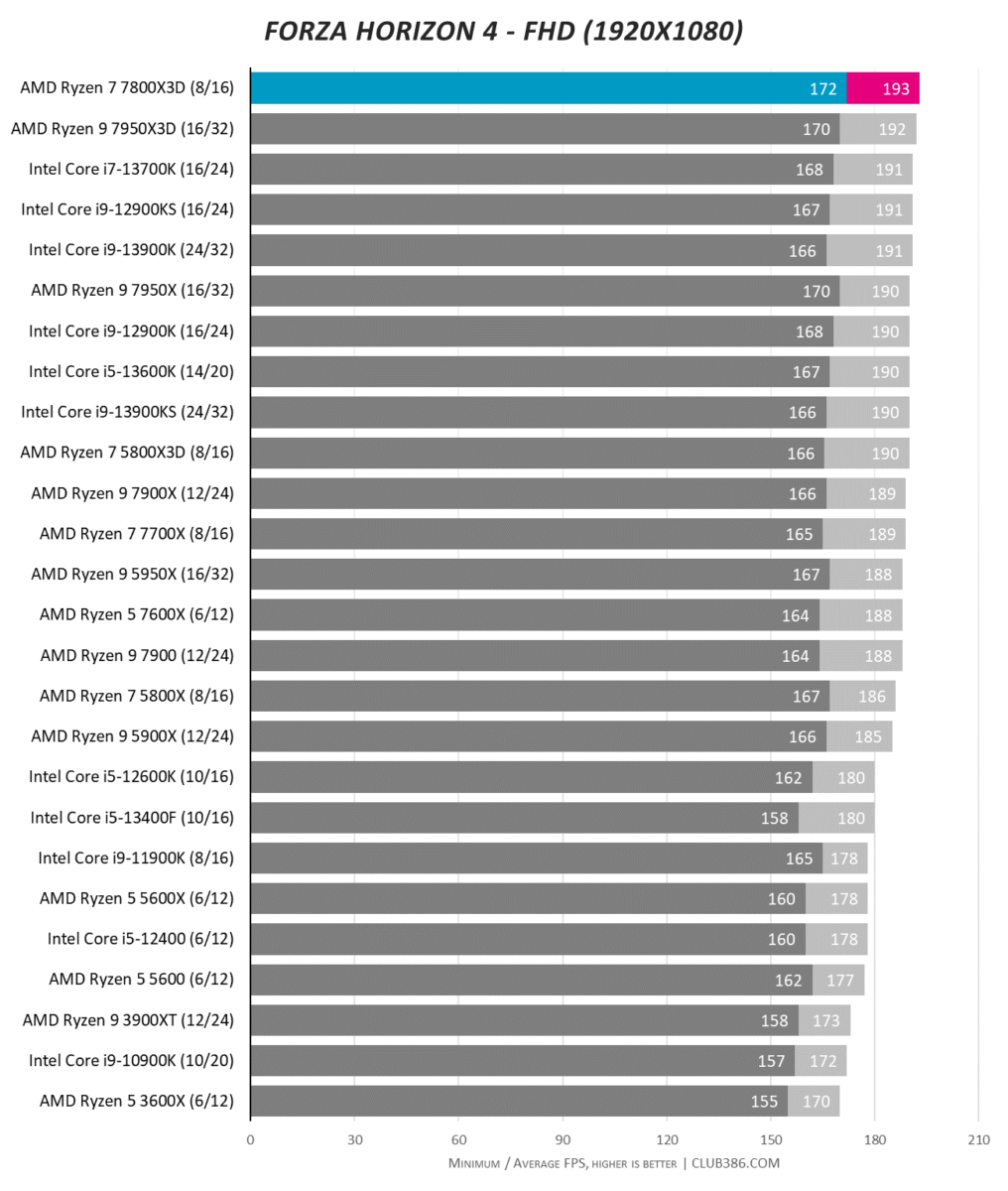
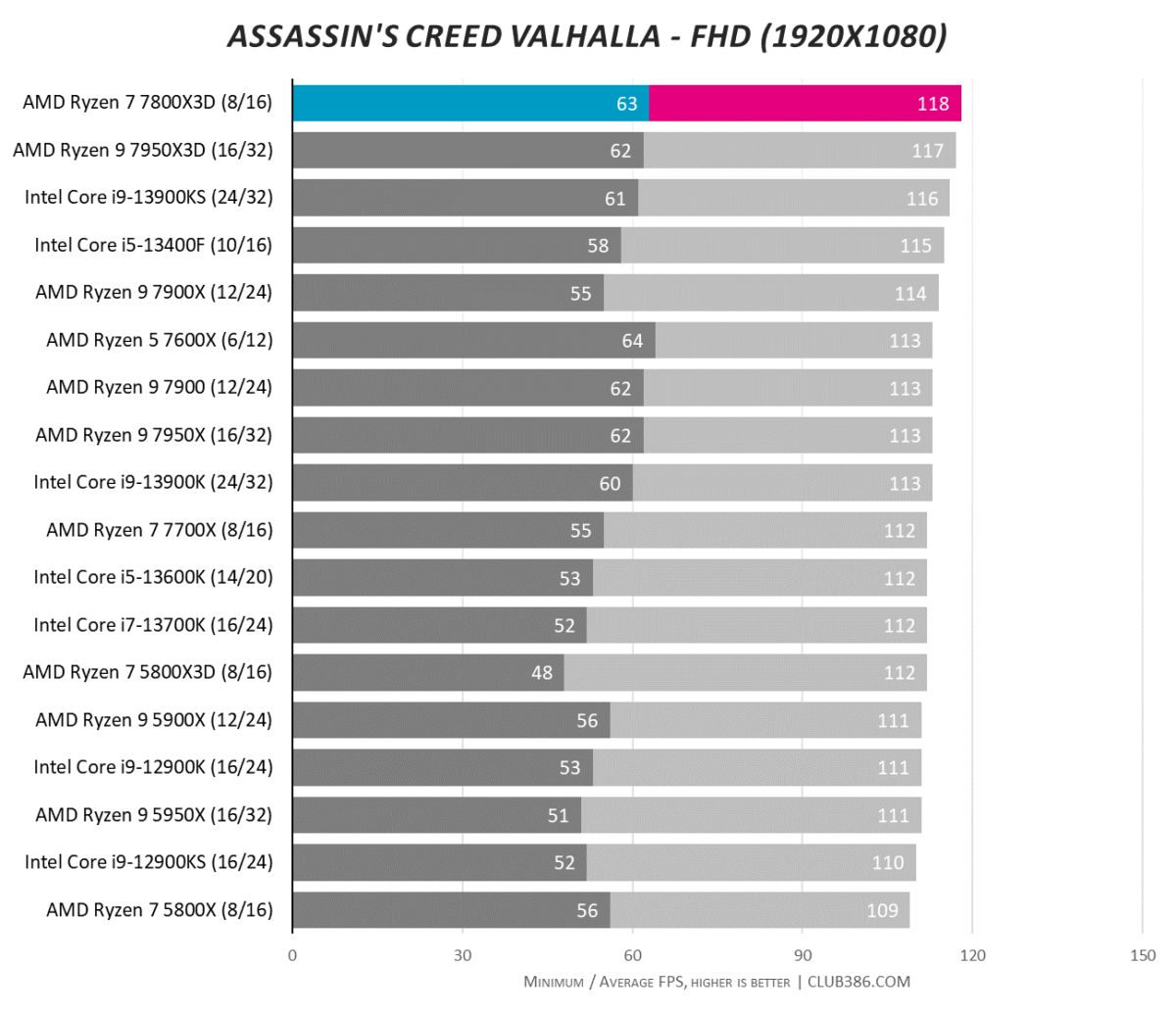
Arguably more important than the average is the excellent minimum framerate. X3D has gaming legs.
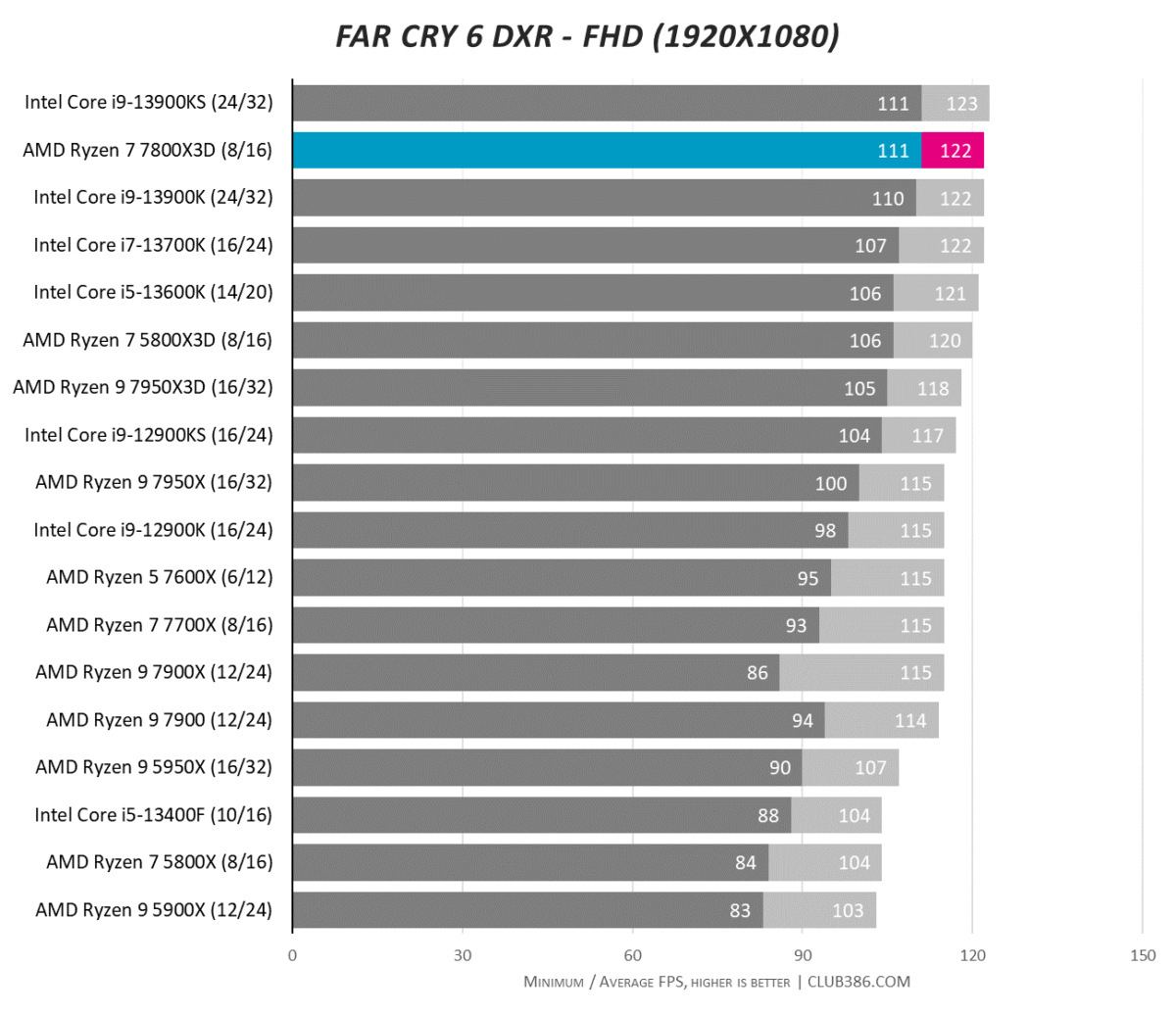
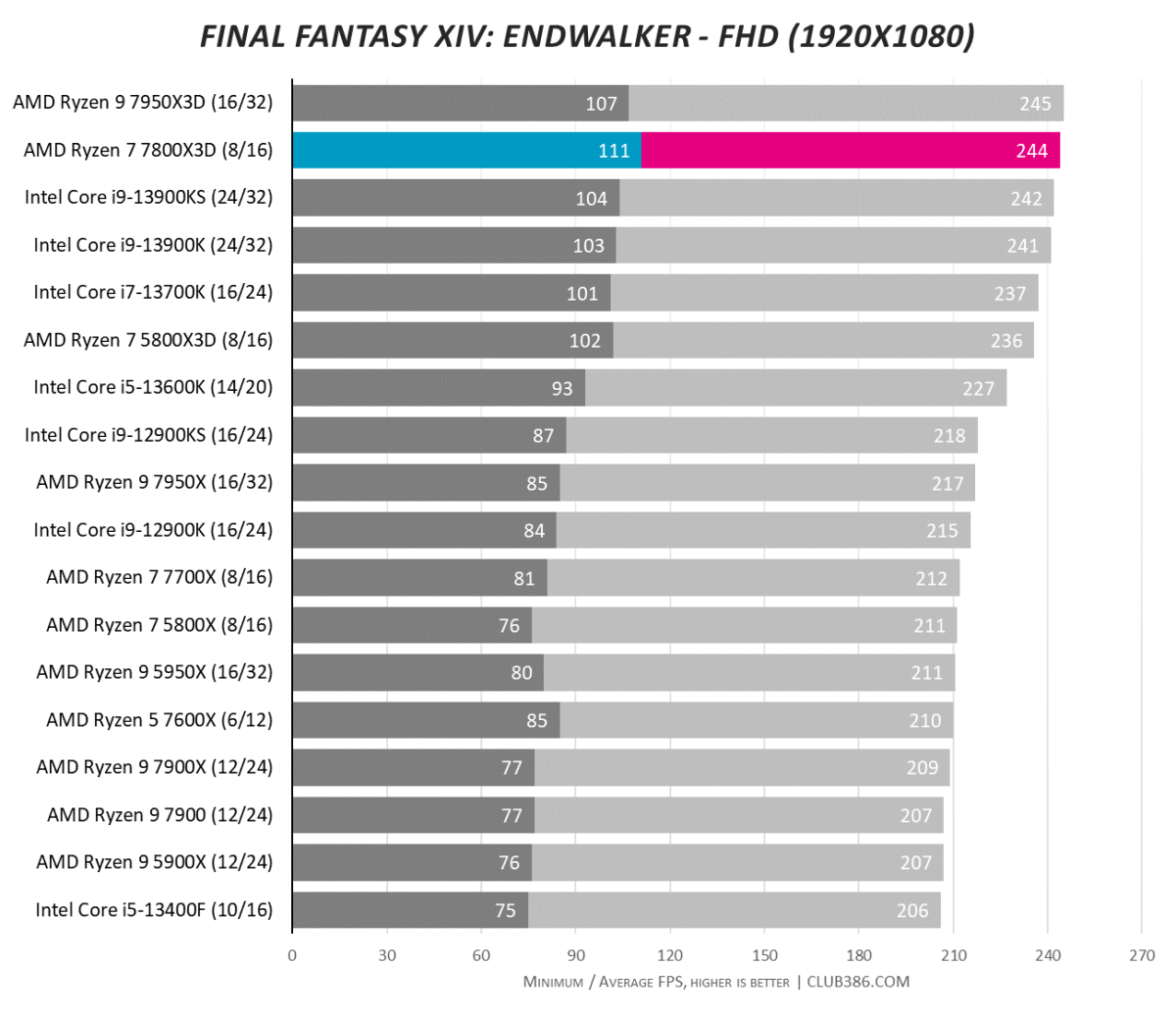
Ryzen 9 7950X3D and Ryzen 7 7800X3D are interesting as the former wins out on frequency but gives up CCD symmetry. This design approach leads to near-identical results.
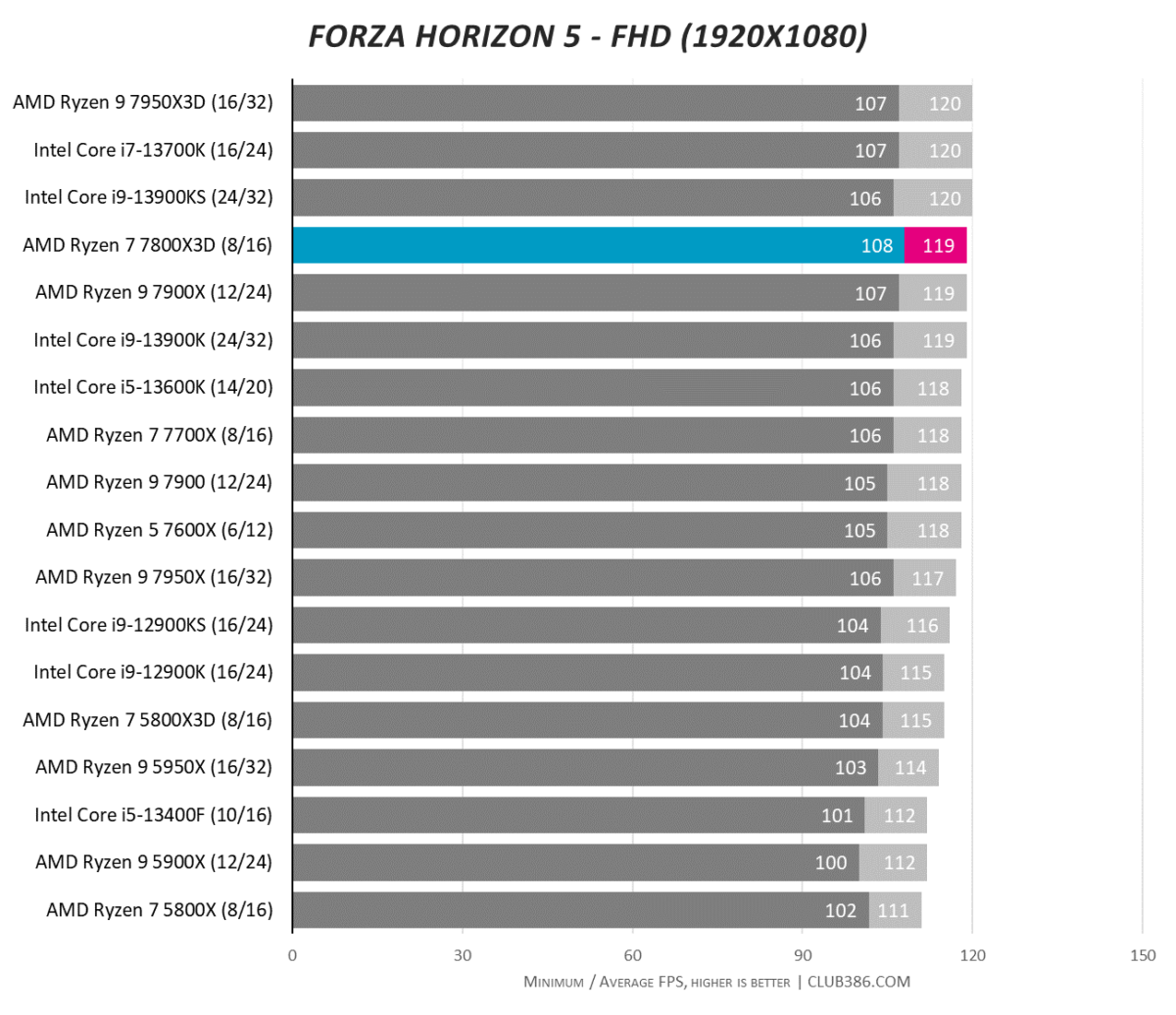
Mostly GPU bound, we feel a chip like 7800X3D would do better, comparatively speaking, with a monster graphics card such as GeForce RTX 4090.
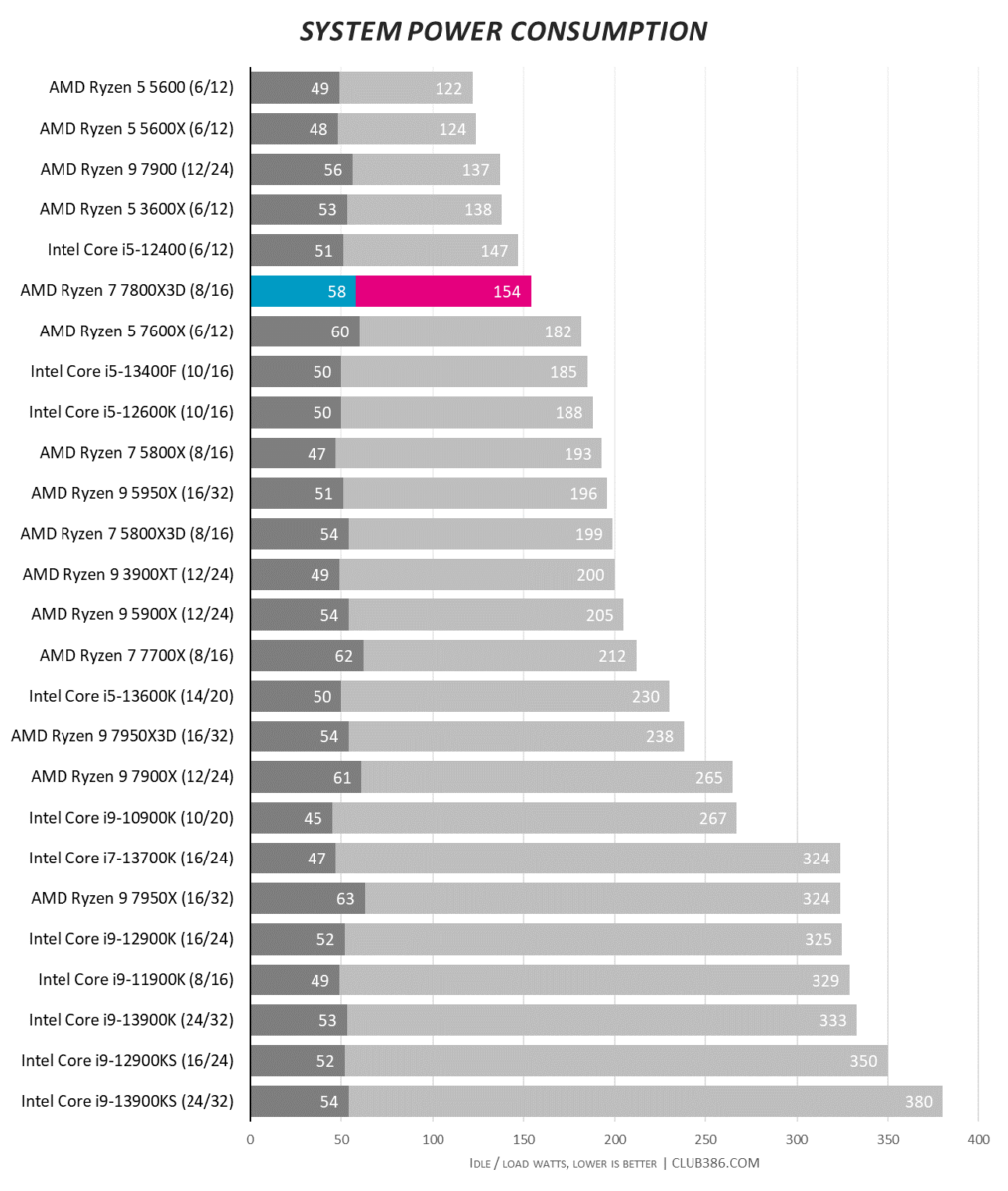
Double-checking results to ensure they’re correct, meagre system-wide power consumption in multi-threaded tests is no fluke. Let’s explain why.

Here’s the same Cinebench test run on a 10-minute stability setting. What’s readily apparent is AMD’s insistence on the chip not running too fast. Humming along at around 4.8GHz for all cores, there’s plenty of scope left in the tank. We know this because Ryzen 7 7800X3D pulls only 50 per cent of the maximum PPT figure.
In fact, the total package is running at around 70W, instead of 120W, mostly due to AMD not wanting it to exceed 5.0GHz at any point. Assuming sufficient silicon quality, could this processor run at, say, 5.5GHz with the same TDP/PPT? Absolutely. But then what hope for Ryzen 7 7700X?
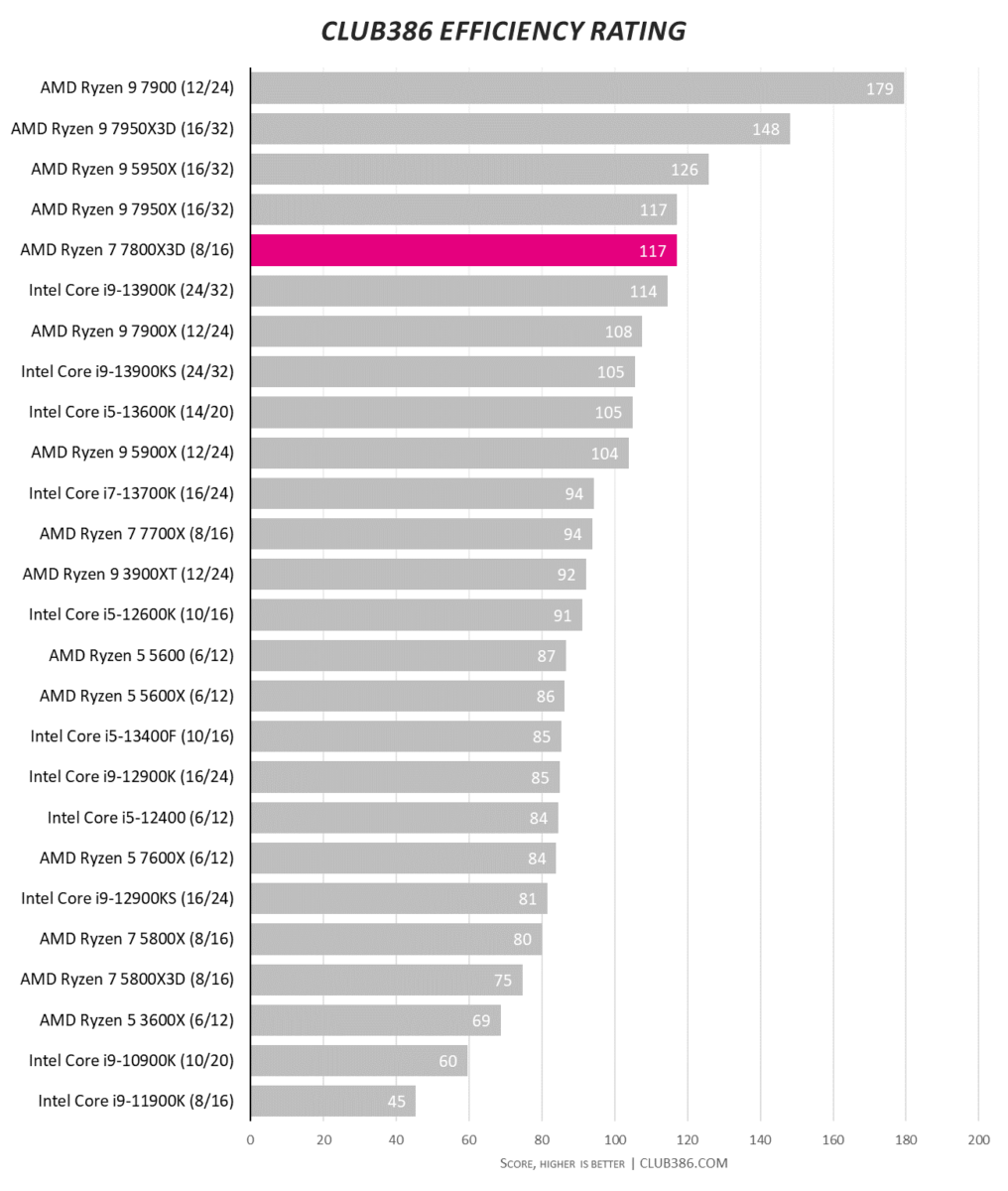
This graph divides the multi-core Cinebench score by system-wide power consumption. It’s a case of mid-pack performance meets restrained power, resulting in a relatively high placing.
If one extrapolates out to gaming instead of multi-core applications, Ryzen 7 7800X3D offers an undeniably impressive metric.
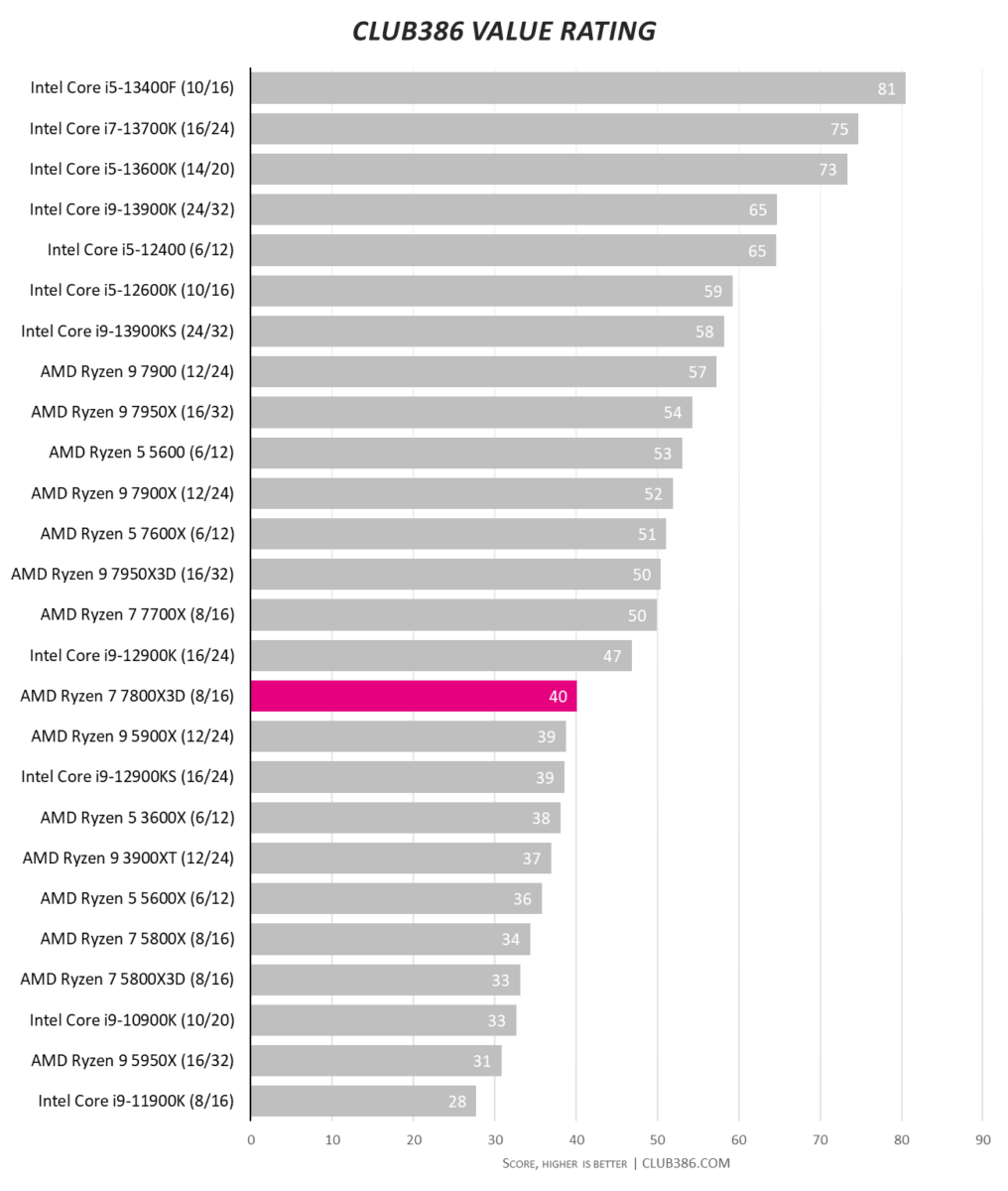
Calculated by dividing the same multi-core score by recommended pricing set at $449, things are not so rosy.
Conclusion
AMD tore up the PC gaming rule book when introducing cache-enriched Ryzen 7 5800X3D roughly a year ago. Building on Zen 3 smarts by slapping on lots of extra L3 cache, comparative framerate was excellent. The right product for the right time.
Since then, the PC landscape has changed, for the better, through the introduction of multiple Intel 13th Gen Core processors, excelling in multi-thread oomph and gaming in equal measure. It’s hard to ignore frequency and caching uplifts over the already decent 12th Gen Alder Lake cohort.
This upwards Core trajectory is what puts AMD in a small bind. Considered in isolation, today’s Ryzen 7 7800X3D is a fabulous gaming processor, but it’s one of many, rather than in a league of its own.
AMD’s decision to limit frequency to 5.0GHz, with no clear opportunity of scaling through regular overclocking, is the processor’s Achilles heel. Most readily apparent in everyday workloads where Ryzen 7 7800X3D is taken to task by other Zen 4 chips, as well as a multitude of Core, it’s not a fair fight.
Such a notion would ordinary sit well with gamers who desire lusty framerates above all else. Whilst very decent in the grand scheme of things, 7800X3D doesn’t carry the same visceral impact 5800X3D had on its arrival. Yes, it’s certainly better, but one must ask the question, irrespective of a forward-looking platform, whether it’s worth 50 per cent more – £450 vs. £300 – and that’s a tough sell right there. Cheaper Core chips that are almost as good in gaming and up to 50 per cent faster for multi-core workloads pile on further worry.
There’s the rub. Ryzen 7 7800X3D would make a lot more sense if allowed to scale closer to 6GHz, because it needs that headroom to fend off high-frequency Core. Yet AMD cannot allow that, as a $449 processor with these attributes would render $399 Ryzen 7 7700X wholly redundant.
Still a brilliant gaming processor, AMD’s curious product positioning means a little too much speed is left on the table for Ryzen 7 7800X3D to become a must-have upgrade.
Verdict: Delicious in gaming, AMD’s frequency cap puts the newest X3D in a tight spot.

